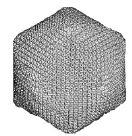Plant Pathology, Department of

James Van Etten Publications
ORCID IDs
Stefan M. Kast: 0000-0001-7346-7064
Gerhard Thiel: 0000-0002-2335-1351
Document Type
Article
Date of this Version
5-2017
Citation
J. Am. Chem. Soc. 2017, 139, 7494−7503
DOI: 10.1021/jacs.7b01158
Abstract
Gating of ion channels is based on structural transitions between open and closed states. To uncover the chemical basis of individual gates, we performed a comparative experimental and computational analysis between two K+ channels, KcvS and KcvNTS. These small viral encoded K+ channel proteins, with a monomer size of only 82 amino acids, resemble the pore module of all complex K+ channels in terms of structure and function. Even though both proteins share about 90% amino acid sequence identity, they exhibit different open probabilities with ca. 90% in KcvNTS and 40% in KcvS. Single channel analysis, mutational studies and molecular dynamics simulations show that the difference in open probability is caused by one long closed state in KcvS. This state is structurally created in the tetrameric channel by a transient, Ser mediated, intrahelical hydrogen bond. The resulting kink in the inner transmembrane domain swings the aromatic rings from downstream Phes in the cavity of the channel, which blocks ion flux. The frequent occurrence of Ser or Thr based helical kinks in membrane proteins suggests that a similar mechanism could also occur in the gating of other ion channels.
Includes Supporting Information


Comments
© 2017 American Chemical Society. This is an open access article published under an ACS AuthorChoice License, which permits copying and redistribution of the article or any adaptations for non-commercial purposes.